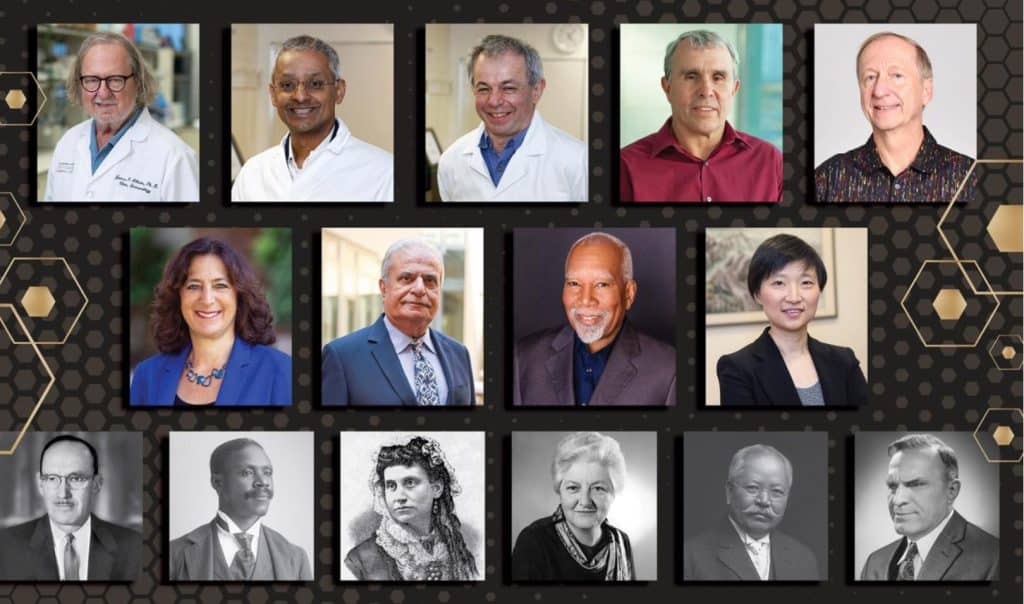
These 15 innovators have shaped our society and touched our lives by pursuing their passions in diverse fields and developing inventions as varied as cancer treatments, agricultural machinery, super-resolution imaging technologies, and theatrical technologies and special effects.
James Allison
Immune Checkpoint Blockade Therapy
James Allison brought immunotherapy into mainstream medicine as an effective treatment for cancer. He applied his revolutionary laboratory findings to develop ipilimumab — the first in a class of drugs known as checkpoint inhibitors — to treat late-stage melanoma, and he was awarded the Nobel Prize in Physiology or Medicine in 2018.
Shankar Balasubramanian and David Klenerman
Sequencing-by-Synthesis (SBS)
Enhancing our understanding of life, Shankar Balasubramanian and David Klenerman co-invented Sequencing-by-Synthesis (SBS), a Next Generation DNA Sequencing (NGS) method that made possible efficient, low-cost and large-scale genome sequencing. SBS has enabled significant advances in genomics, medicine and biology.
Eric Betzig and Harald Hess
Photoactivated Localization Microscopy (PALM)
Eric Betzig and Harald Hess co-invented PALM, a super-resolution imaging technology that allows scientists to look inside cells with unprecedented resolution. Through imaging at the nanoscale, biological structures, processes and diseases can be studied with much greater clarity.
Joseph-Armand Bombardier
Snowmobile
Joseph-Armand Bombardier invented the Ski-Doo® snowmobile. The first mass-produced snow machine, it set industry standards and launched snowmobiling as a sport and recreational activity.
Andrea Goldsmith
Adaptive Beamforming for Multi-Antenna Wi-Fi
Andrea Goldsmith created technical innovations including adaptive beamforming for multi-antenna Wi-Fi, shaping the performance of wireless networking and enabling the fast, reliable wireless service used worldwide for working, shopping, communication and entertainment.
Asad Madni
MEMS Gyroscope for Aerospace and Automotive Safety
Asad Madni led the development of the MEMS gyroscope for aerospace and automotive safety, which was commercialized as the GyroChip. First applied in the aerospace and defense industries, this technology has saved lives around the world through its use in aircraft and passenger vehicles.
George Washington Murray
Agricultural Machinery
George Washington Murray invented and patented agricultural machinery designed to accelerate planting and harvesting processes in the late 1800s. He also served in the U.S. Congress and advocated for greater recognition of his fellow Black inventors.
Mary Florence Potts
Cold-Handle Sad Iron
In the 1870s, Mary Florence Potts developed an improved sad iron, or “solid” iron, which was lighter and offered a cooler, more ergonomic handle compared to other irons available at the time. Potts’ invention was widely commercialized as an easier, safer solution for ironing clothing and linens.
Lanny Smoot
Theatrical Technologies and Special Effects
Disney Imagineer Lanny Smoot is the patent leader (with over a hundred patents) at The Walt Disney Company, and has developed many special effects, interactive experiences, new ride vehicle and robotic concepts and other technological advancements for Disney’s theme parks, attractions, resorts, hotels and cruise ships, creating magical guest experiences and driving innovation for future attractions.
Alice Stoll
Fire-Resistant Fibers and Fabrics
A research physiologist and pioneer in aerospace medicine, Alice Stoll led the development of fire-resistant fabrics in the 1960s. Her work made it possible to rate materials by their ability to protect from thermal burns and demonstrated that fabric constructed with fire-resistant fibers was superior to fabric treated with a flame retardant.
Jokichi Takamine
Adrenaline (Adrenalin®)
Chemist and entrepreneur Jokichi Takamine was a biotechnology pioneer whose research led to the use of adrenaline in medicine. Also known as epinephrine, adrenaline is widely used for many applications, including the treatment of anaphylaxis and cardiac arrest.
Ralph Teetor
Cruise Control
Automotive engineer Ralph Teetor invented cruise control in the 1940s. Originally limited to luxury vehicles, this speed control technology has become a standard feature providing greater ease in driving, safety, as well as fuel efficiency benefits.
Xiaowei Zhuang
Stochastic Optical Reconstruction Microscopy (STORM)
Xiaowei Zhuang introduced one of the most widely used methods of super-resolution imaging: STORM. Used to investigate biological systems and processes, this technique overcomes the diffraction limit of light to produce images with higher resolution than what is possible by conventional light microscopy.
Join Us in Celebrating Our 2024 Inductees
These world-changing creators, innovators and entrepreneurs will officially join the National Inventors Hall of Fame family at our Induction Ceremony in Washington, D.C., on May 9, 2024.